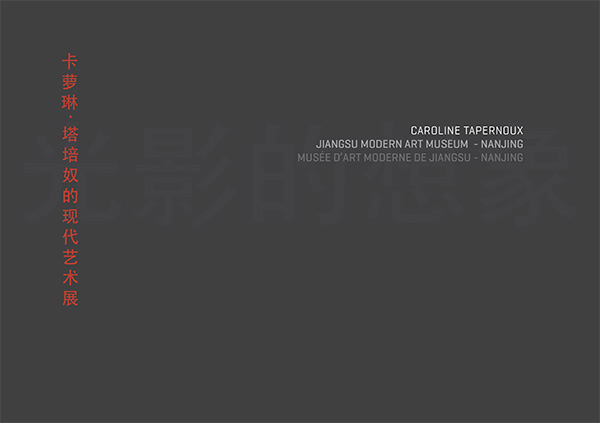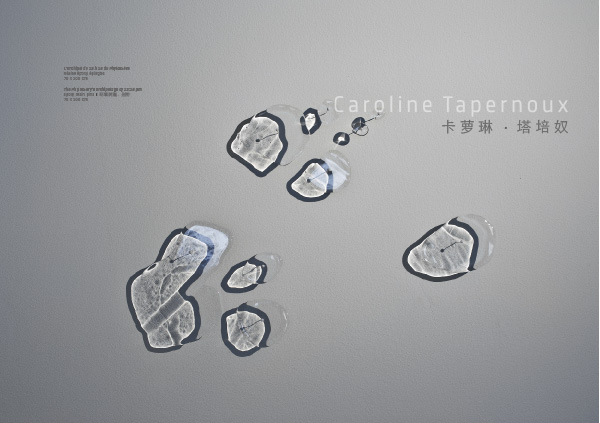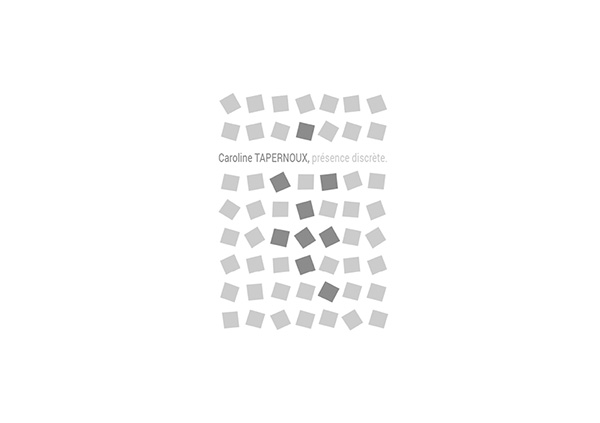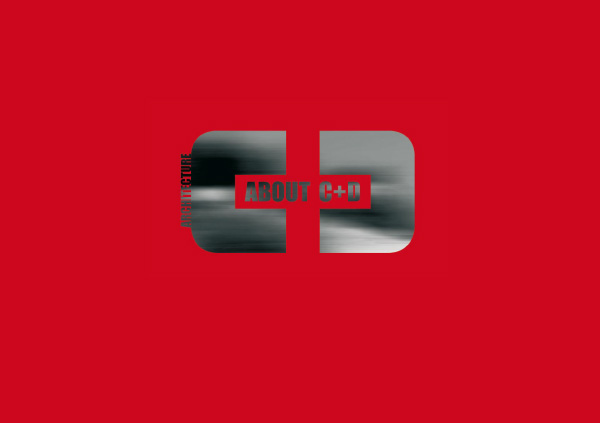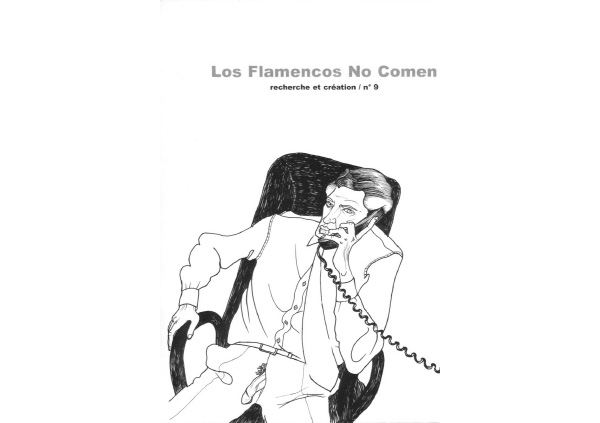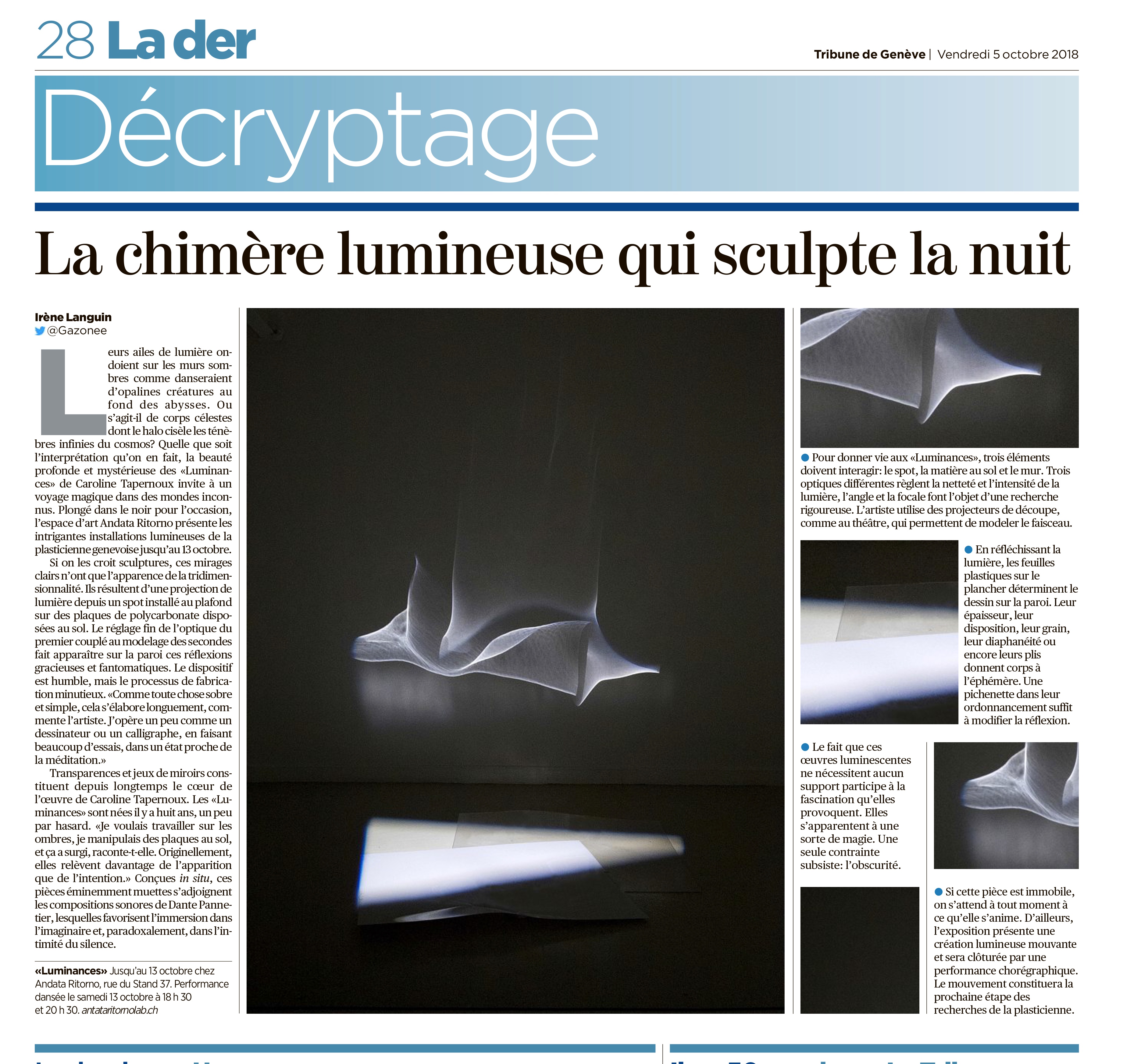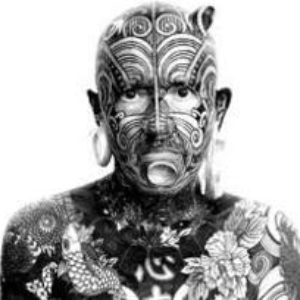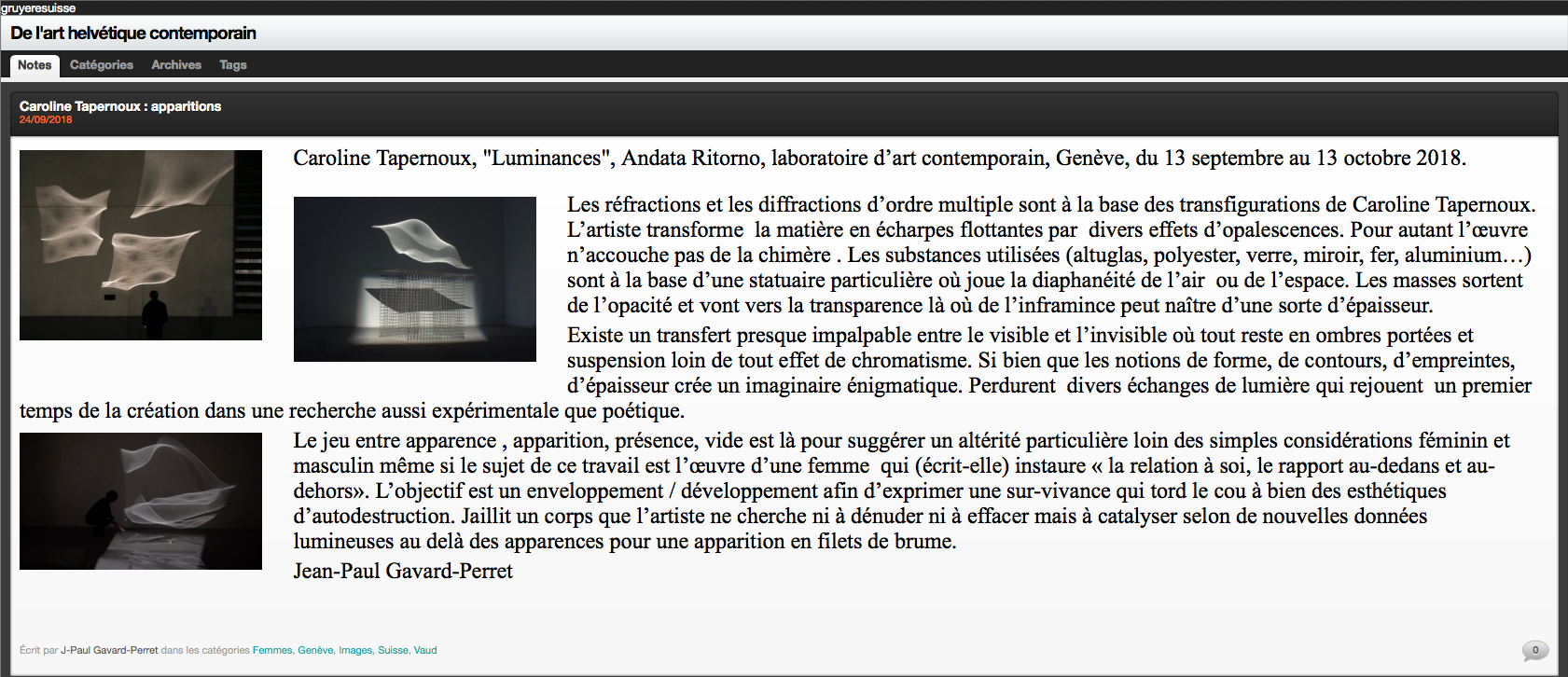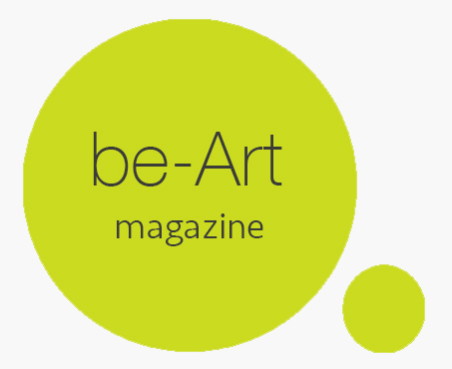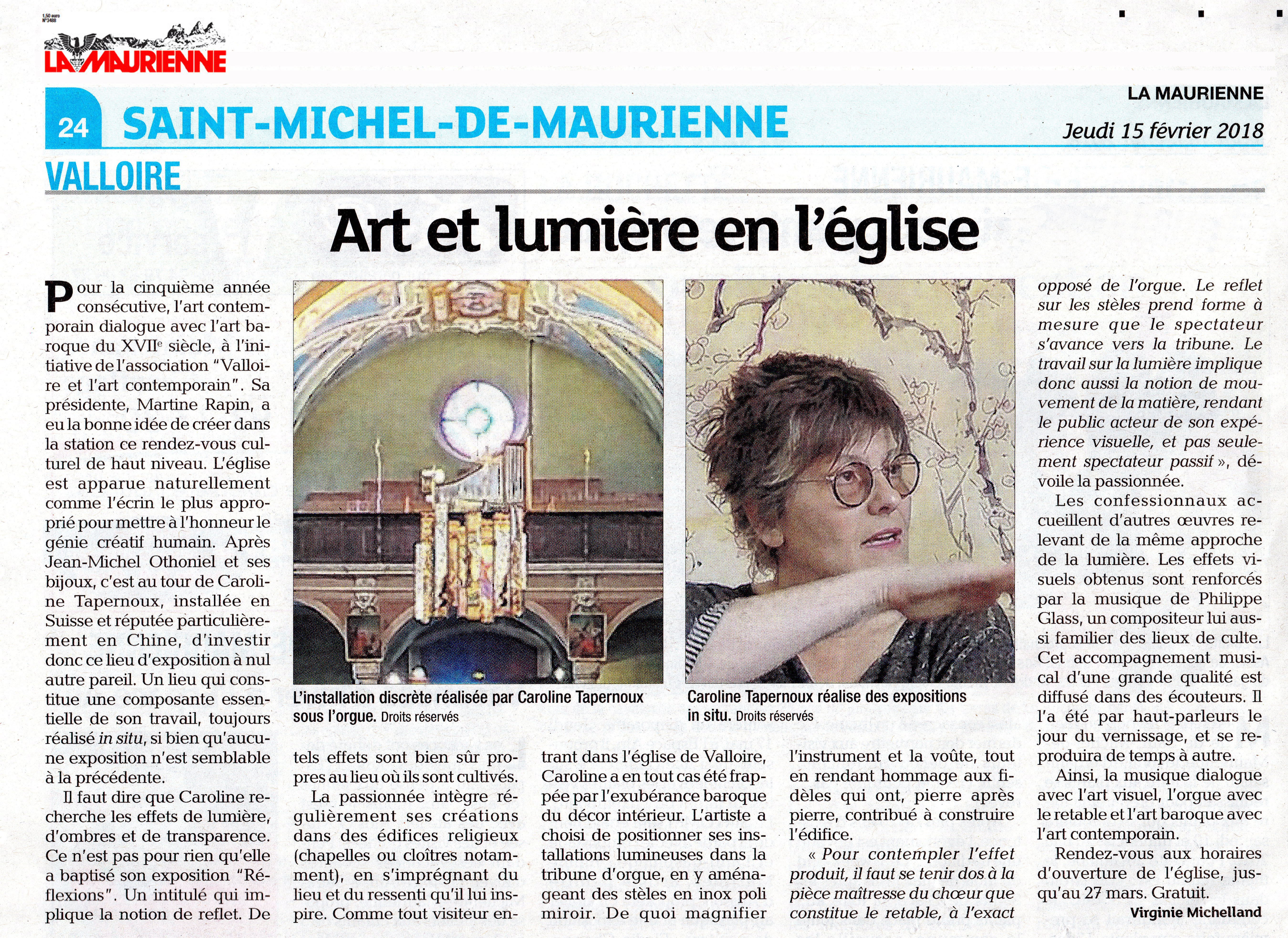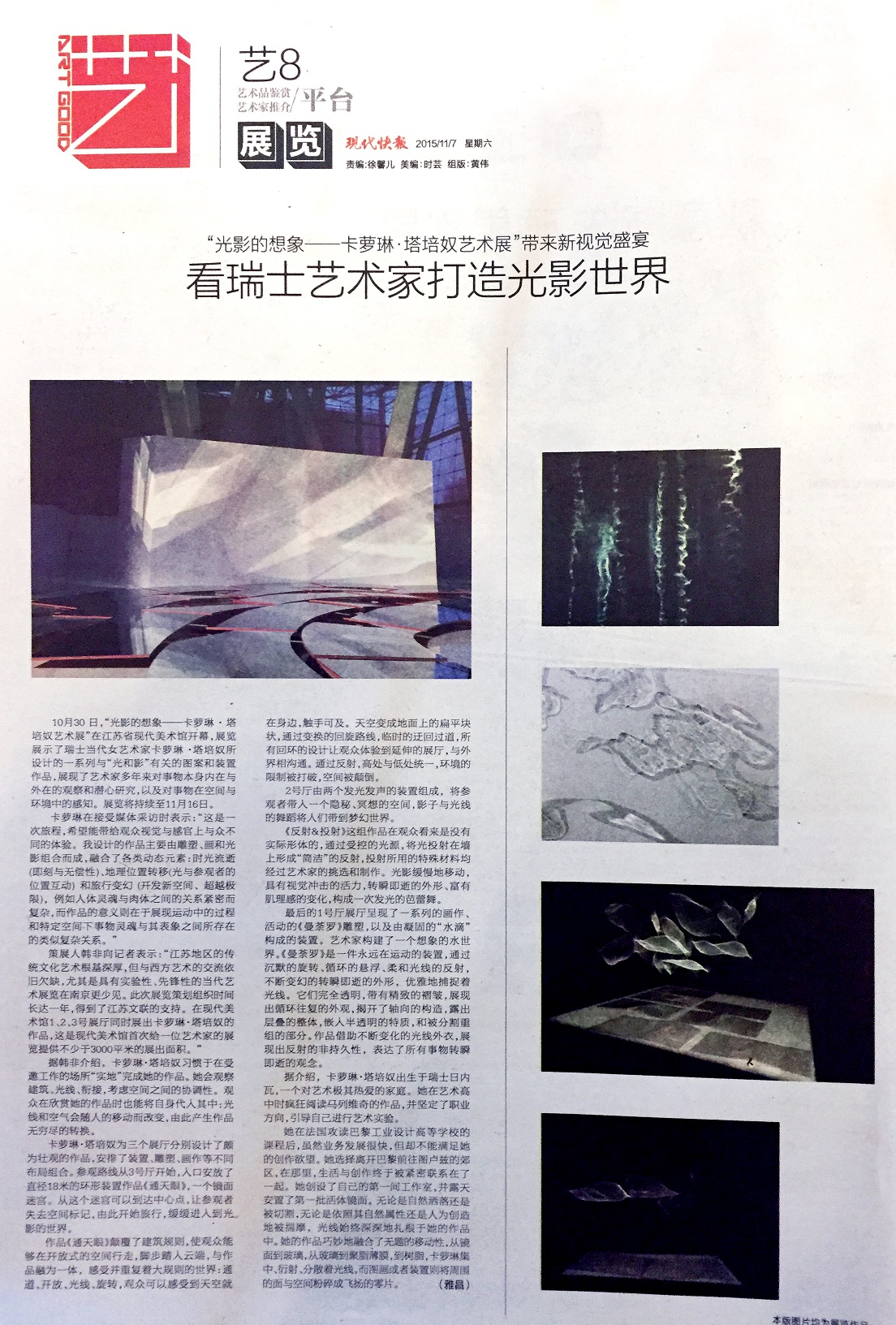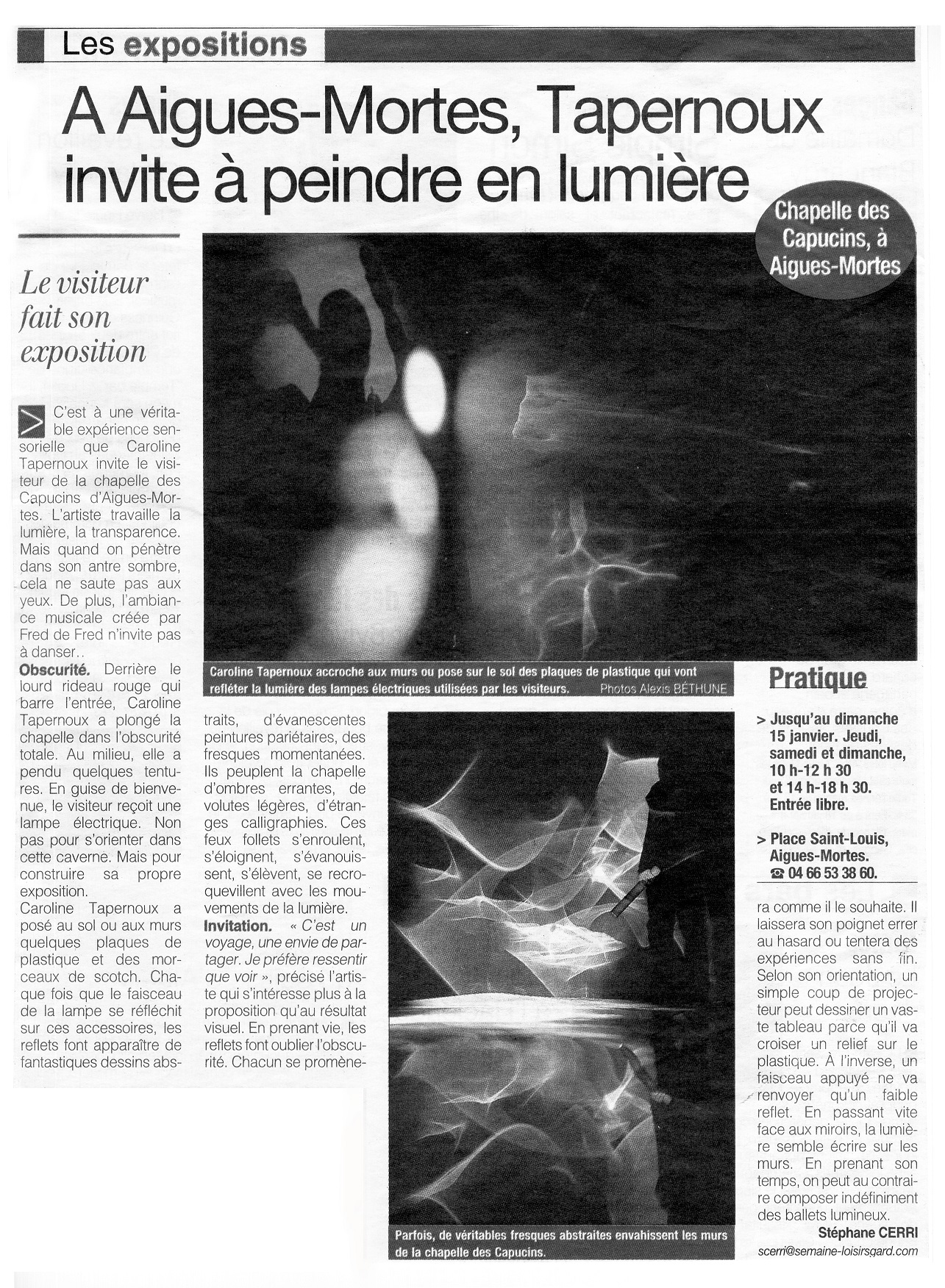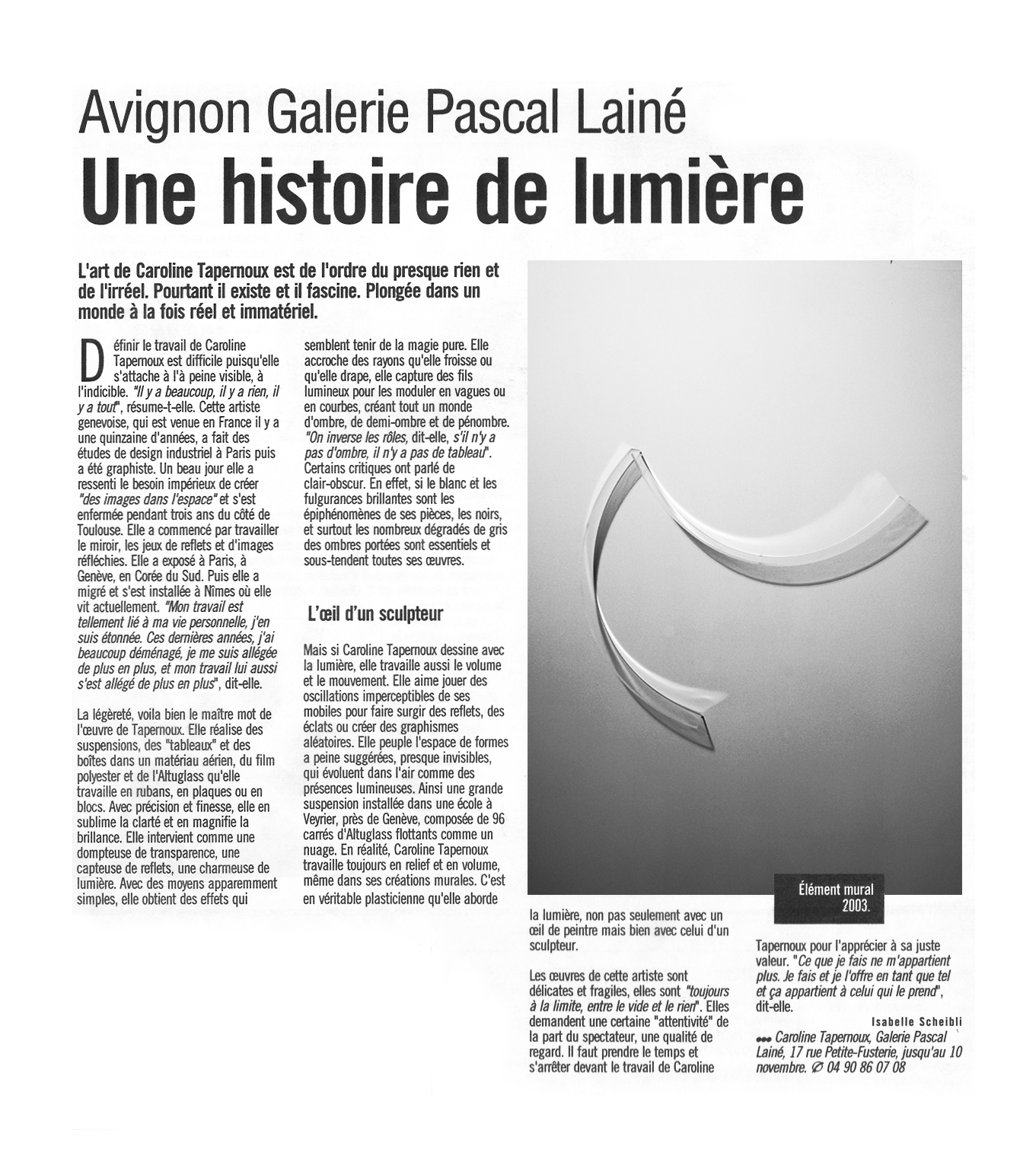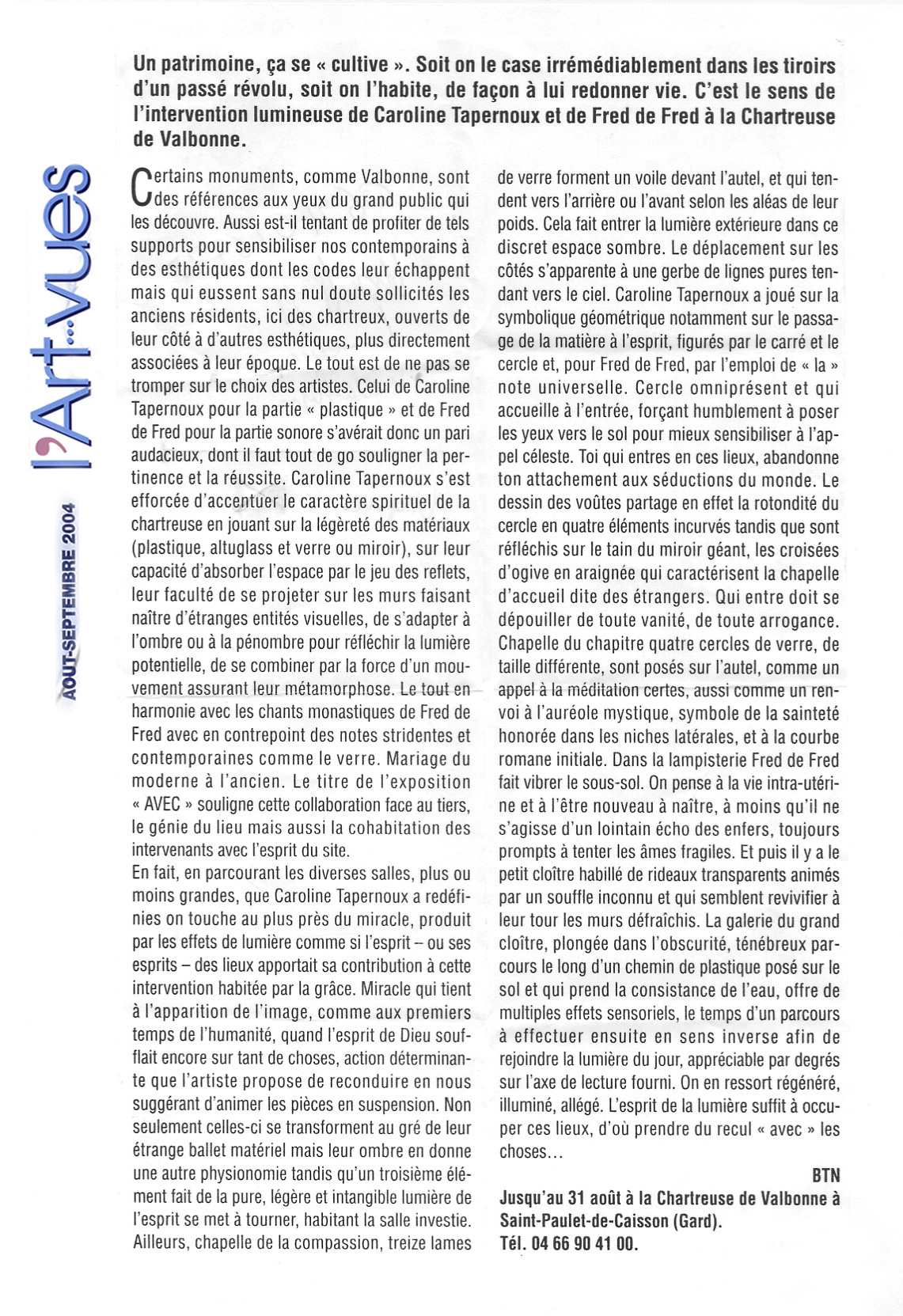-
Texts
CHOREOGRAPHED LIGHT
by Florian Besset (rooms of the Castle of Barjac)
2019 I Solo show I La Quincaillerie galery and the castle of Barjac, FranceRoom 1
Binôme #2 (rooms 1 of the Castle of Barjac)Tribute to a passed person, expression of pain itself but also of faith in life, this artwork was inspired to Caroline Tapernoux by an especially hard grief.The light is lowered. But like a lowered flag can be raised again to deploy its colours with magnificence in front of the eyes of everyone, from the confiscated light can re-birth the beauty of the light, source of life: the punctuation of immerged red cellular elements in the circle of confiscated light evokes the red cells promising a possible re-birth, germs of the return to beauty, of a return to life. Caroline Tapernoux works « in situ » which means that she chose the ceremonial room of the Castle of Barjac to offer to this powerful artwork the framework of dignity and deference it deserves.
Victor Hugo wrote:
« Death and beauty are two deep things
Which contain as much shadow and azure that they seem
Two sisters equally terrible and fruitful
Keeping the same enigma and the same secret . »*
* Victor Hugo, Complete Poems (Poèsies completes), Tome III, éd. Seuil 1972The Minotaure and the Star (rooms 2 of the Castle of Barjac)
Caroline Tapernoux in a certain way spiritual daughter of Kasimir Malevitch which she studied the work and the writings, knows that abstraction in his work was more about an metaphysical absolute than a plastic construction with no sense. If contemporary art is far too often neglecting beauty and spirituality, Caroline is the representative on edge for whom the metaphysic (the beyond of things), the intelligible and the sensible could not be separated, as they are not distinguishable in reality. « The truth of art is its power of life»*. Power which beauty and spirituality are fully part of.The Luminances created for this room play magnifically with the particular structure of the walls, becoming almost a parietal art of the light. The tension of forms coming from the radius projected on the polycarbonate sheets delicately deformed reminds the mastership of the line and the exploitation of the reliefs of the Prehistory Masters, for instance the Chauvet grotto nearby, these artists whom perception of the world was not yet alterated by no school, no institution or self-appointed chapel holding the truth of art.
Gérard de Nerval :
« Respect in the beast an acting spirit
Each flower is a soul with a bloomed Nature;
A mystery of love lies in the metal;
All is sensitive! And all on your being is powerful. »*** Jérôme Alexandre, L‘art cotemporain, un vis-à-vis essentiel pour
la Foi, Collège des Bernardins, 2010
** Gérard de Nerval, Les vers dorés, Forgotten Books, 2018The Carmélites (rooms 3 of the Castle of Barjac)
After the penumbra of the room 1 and the obscurity of the room 2, here we are in the bright light generously distributed by the south and west windows of this beautiful room.
The artwork conceived « in situ » was supposed not to have any title but, to designate by chance during a conversation, Caroline named it very spontaneously « The Carmélites ».
By chance? I do not think so. These two volumes very simple, made of sanded polycarbonate that capture the light with great softness and seem in the middle of a whispered exchange, evocate the two young novices of the movie « The Dialogue of the Carmélites »*, and the notion of contemplation to which the work of the artist invites so often.
By their luminosity, these figures establish an intense dialogue with the surrounding architecture, glorifying it and call inside the spectator the esthetical emotion synonymous of beauty, key moment of an inner reconciliation between the opposites that live inside ourselves.Giorgio de Chirico :
« Silent life, listening, hearing, learning to
express the hidden voice of things, here is the path
and the goal of art. »*** Film by Philippe Agostini (1960), dialogues by Georges Bernanos, with Jeanne Moreau, Allida Valli, Madeleine Renaud, Georges Wilson, Pierre Brasseur, Jean-Louis Barraud). Le Carmel est un Ordre contemplatif.
** Giorgio de Chirico, L‘Histoire de l‘art est-elle finie?, Jacqueline Chambon, 1989Reflexions on Plato’s and Baudelaire’s Cavern and its incredible fallouts of re-birthing lights
by Joseph-Charles Farine
2018 I solo show I Andata.Ritorno galery, Geneva
DOWNLOAD TEXT
« Your shadow is there, on my table
And I would not know how to tell you
That the false sun of the lamps arranges itself with it »
Léo Ferré, (The letter)« In the darkness, there is not a single place for beauty. The entire place is devoted to the beauty. » René Char
There is something about the work, or I would rather say about the artwork of Caroline Tapernoux, as a challenge to the night, Caroline inhabits the night with that intensity that is defining the occupation of a being or a place, like we talk about an inhabited being. Transparency in her artworks is about the same exigency of any true life, namely the one of urgency of the instance, which the researches have been immense although the result is evident. The impregnation of the clarity that the artist disposes, studies, thinks, constructs, works, with eventually this blessed bread that is the result eventually conquered.
Shadow is light’s sister like day is night’s cousin, we would finally say that it is a family story about Nietzsche who hated this concept of family comfort but well at that time that was about a different context of our metaphor.
There is a very beautiful story anchored in the Greek mythology deepness namely that the fundament of all writings and the story of drawing would be the creation of a young woman which father Dibutades was a sculptor potter. The in love woman would have drawn the shape of her lover who was leaving for war so her father could realize a 3 dimensional artwork of it. This story, true or not, is about a touching emotion anyway namely that the origin of drawing would come from the time deepness by this gesture of indubitable grace and charm.
The Luminances of Caroline Tapernoux come from a sculptural disposal apparently simple but of a factual intelligence and an extreme mastership out of modern materials but that we will call more likely basic from a technical point of view namely the projectors with exact and calculated optic, hanged on the ceiling projecting their light on the polycarbonate pieces on the floor, shaped to make appear on the wall of these darkened rooms figures in which some could see like Nerval’s chimeras, and others like unexpected medusas, eventually just like when one look at the clouds, each one will finally see in those, his own images through the power of individual imagination.
I always gave in my program a particular attention to the fields of shadow, reflect, light and mirror as it is true that I am convinced that shadow namely an immaterial drawing is a metonymy itself of art’s fundamental entity namely a research of immaterial and spiritual values throughout the ultimate necessity of materials without which art would be summarized at the invisibility of closed eyes.
The drop shadows are the excellence and the grace of the actual season of autumn.
The paradox is that we had to darken this art space that has Cistercian light quality for the needs of visibility of this sublime show in this mordorant autumn. This autumn about which Leo Ferré was saying « the yellow bandits who are making mordoré hold ups at the trees ».
The drop reflects give us a sharper vision on the world, a more resonating one and Caroline Tapernoux builds the Luminances where the nocturnal alcove takes its entire meaning, in a paradoxical remembrance of the caverns which since Lascaux will not stop being the clandestine decor of eternal writings.
What about the subtle and miniscule perception of light at the time where the cathodic screen fills the look bringing to blindness? The contemporary vision is tyrannized by the domination of zapping, this is the reason why the stake of artistic works inviting to the time of silence and sensible impregnation becomes a strength facing the superficiality of diarrheic and spectacular imagery.
« Mehr Licht » used to say Goethe. Caroline out of the impact of light makes infinitesimal, sensitive images at the antipodes of surrounding technological virtuality. She offers to us her images, as a gift, a present, a chance and eventually why not AS A DREAM LONGER THAN THE NIGHT.
Joseph-Charles Farine
2018, October 4
Caroline Tapernoux, light Staging, shading.
par Marielle Barascud
2014 I Catalogue
Download text
Glass plates
Mirror discs
Polymethacrylate strips
Polyester films
Resin streaks
Acrylic mirror
Unfilled blister packs
Making black gleam, overshadowing light. Moving from volume to plane, constructing space with a mere sheet of matter.
For a long time, Caroline Tapernoux’s goal has been to extract the juice, the sap, to press, to distort and turn the materials that she chooses to use for her pieces inside out – a frenzied rigour in the choice of components, in the research and improving of techniques, to attain both an almost visible and almost invisible result.
These components have become more and more diversified in the course of her plastic research. They have grown lighter (polymethacrylate), more flexible (polyester), and even shapeless (resin) or misappropriated (blister packs). But this does not prevent Caroline from using them concomitantly.
Is time not an integral part of the luminous phenomenon?
Indeed, the subject here is truly light, in the sense that it links the different stages of Caroline Tapernoux’s pieces as it weaves its way through them. It is projected or reflected onto their various materials or supports. In turn passive or active, it transforms them, transfigures them in order to inscribe and construct the projected shadow. It shades, densifies transparencies, and darkens blacks.
And still it makes the drawing vibrate, reveals small and insignificant things, and makes them essential.
It gives the object its autonomy, enables those who see it every day to witness a continuous activation, an infinite re-creation.
Here, the artist creates the object, light creates drawing, and the spectator creates his own work of art. The impermanence of the piece stages a spectacle, a perpetual representation. It is up to each of us to grasp the small aspects that will make the piece “every time not quite the same/not quite another”…
Caroline Tapernoux’s work is made up of families that interpenetrate and self-fertilise one another. The mobiles send back the reflections captured by their altuglas sheets; mirages spring up from installations; the photographs of blister packs memorise the structures of a reference packaging; light circulates and breathes through the paintings.
The image (of the mirror) is acted out.
These transparencies are the opposite of an unveiling, in that they are not a way of bringing out the essential in what is superficial, or of delving from the surface to the core.
They are the acknowledgement of turmoil, the staging of our own shadows.
Did what I see really exist?
Marielle Barascud
Nîmes, September 2012
English translation by Lucy PonsIntimacy is art
par David Brunel
2009 I Le Regardeur n°4, Les Femmes dans l'art ( Women in art) I Edition A.M.A.A.C.
Download text
« L'esprit, pour pénétrer jusqu'aux idées, perce plus difficilement à travers la dure écorce de la nature et de la vie qu'à travers les œuvres d'art » Aristote
To the thematic, almost thetic issue of “women in art”, Caroline Tapernoux will not offer any complete answer; nor will she lay any head-on claim to such a thing; even less will she develop the issue in any formal way; any more than she will inevitably contest it. She will quite simply observe, in a general way, that over and above the difference between the sexes, there is a common artistic gesture, work-in-the-making that is at once joint and several, lending otherness to its vague idea—at least it is vague with regard to the relation that the artist has with his or her work.
But admitting one’s insensitivity to this difference is not being indifferent to sensitivity (including feminine sensitivity, it should be said). What is essentially underscored by Caroline Tapernoux’s stance, straight away ruling out the differentiation between female and male, is neither a theoretical flight, nor a diplomatic solution; nor, needless to add, is it a muddling of genres. No, more significantly than this, it indicates that her viewpoint does not readily, in the case here in point, incorporate the sociological issues inherent to art understood in its history, by which we mean identity, machismo, feminism, protectionism, network, sectarianism, ostracism, emancipation… In a word, everything that is subject for discussion and/or argument. Rightly or wrongly stated—this is no longer the nub of the problem—these challenges do not interfere with the artist’s work; all that matters for the artist is the creative act, and this is certainly what Caroline Tapernoux seems to display.
So what is left of the initial subject? What is left of “women in art”? The subject itself, is our reply. So it is no longer a matter of a subject as motif, but rather of a subject as person, of an emotive, incarnate subject: a woman, Caroline Tapernoux. She in her being there, she in her studio, in her life, she who tells us that, from her viewpoint, “the creative act is not masculine or feminine, it is a creative act, it is what matters to me and what helps me to be, it is relation to self, linkage within and without at the same time”. In her own words, “there is, in the studio space, a power of envelopment which unfurls.” This is what she dwells on and emphasizes. “This idea of envelope is dear to me, of paramount importance, it is a way of doing and making and being which is important to me, and which the studio gives me in an apt, significant and necessary way”, she adds. Enveloping, enveloping oneself, being enveloped, having oneself enveloped… Different registers, transitive and reflexive, active and passive, which all come together for her when art is in the making. This moment does not rule out femininity or masculinity: quite to the contrary, it includes them in each other, it merges them, and brings out just man, the human.
Artists know, as André Gide explained, that “art comes about through addition, through pressure of superabundance. It starts precisely where living is not enough to express life.” Caroline Tapernoux does not explain art, she lives it. Art is her support, her base, her mooring in the world, her landmark (definitely in both meanings of the word: both marker and refuge); it is a metaphysical metronome. When she talks about art, or more precisely about creation, she is talking about herself, about herself as she suspects (herself), herself as she looks for (herself), herself as she sometimes loses (herself), and herself as she at times (re)finds (herself). She talks privately. She talks of privacy with all the etymological aura that this superlative channels 1 . In the place where the poet writes: “Check yourself pinch your flesh be” 2 , Caroline Tapernoux creates pieces, sculpts materials; this is how she “pinches her flesh” and “checks” herself.
What, in the end of the day, is involved here? Understood as something to do with necessity and outlet, the act of creation targeted and intimately experienced by this Nîmes-based artist is akin to an avowed form of catharsis, a release—the way it is regulatory and necessary. 3 The Freudian designation of this work of conversion is, as we know, sublimation, a conversion of drives to an end other than sexual, and art is one such, elevating, a catalyst, a useful tool (French outil, which we might write “où-t-il”—literally “where-it”, to considerably alter the meaning of its announcement and thereby draw close(r) to Caroline Tapernoux, and her privacy and intimacy, which we cannot enter, and even less desecrate).
Caroline Tapernoux goes to her studio the way others go on a retreat; she works to find an inner peace; and she strives to think of nothing. “The work of art is thus presented as a pillar of man’s knowledge, and through it man can re-organize his own psychic space” 4. This is what takes precedence in this artist’s work; this is what, de facto, puts feminineness off screen; it is infiniteness that is in the frame, with her.
Thinking about nothing
is having your soul fully to yourself.
Thinking of nothing
is to intimately experience
the ebb and flow of life…
Ne penser à rien
c’est avoir son âme pleinement à soi.
Ne penser à rien
c’est vivre intimement
le flux et le reflux de la vie… ” 5
David Brunel
Doctor of aesthetics,
photographer and plastic artist,
science of the arts teacher.
1) What is innermost, in the very depths of a being, which closely links, and involves the secret life, the private domain, things secret. The prefix in- indicates inward movement (or the spatial, or temporal, position).
2) Christian Prigent, L’Âme, P.O.L, 2000, p. 40.
3) And we do indeed mean the necessity of this doing and making, of this artistic gesture, as defined by Gilles Deleuze in his speech given at the FEMIS in March 1987, whose text, finally published in the magazine Trafic n°27 in autumn 1998 is titled : Qu’est-ce que l’acte de création ? [What is the Creative Act ?]
4) Murielle Gagnebin, Pour une esthétique psychanalytique – L’artiste, stratège de l’inconscient, Coll. Le fil rouge, PUF, 1994, p. 197.
5) Fernando Pessoa, L’Ode triomphale & douze poèmes de la fin d’Alvaro de Campos, trad. R. Hourcade et E. Hocquard, éd. Royaumont, 1986, ouvrage non paginé.
English translation by Simon Pleasance & Fronza Woods.Appearance and apparition
par David Brunel
2006 I Los Flamenco No commen n°9, recherche et création I édition Autonome vivance
Download text
« The visibles themselves are only centred around the nucleus of absence. » (2) Maurice Merleau-Ponty
The appearance of Caroline Tapernoux’s works immediately brings forward a place of sensorial encounters. The blending of light with materials, which the artist cuts, heats up, drills through, curves, melts and assembles, maintains an epiphany, in which vision spontaneously immerses itself, and within which the visible increases.
Indeed, the many refractions and diffractions, which the light organizes on the surfaces it lands upon, outline the transfiguration of the materials themselves, while going beyond them. Not only do the ensuing luminous membranes animate the exhibition space, but they also appeal to everyone’s imagination. So, on the edges of these opalescent compositions, one alternately comes across a wave, a cloud, a piece of linen, a drapery, some foliage, or a simple fold… These are all as many illusions that the volutes of light can multiply as much as they wish and that our visual memory can never tire of interpreting.
This contemplative, meditative and dreamlike stage corresponds to a first encounter, a meeting during which things are seen in a playful way, with an aim to recover, locate, recognize, and even recreate a familiar figure within the visible. But this is not where the totality and the purpose of Caroline’s work can be found, and even less its refinement. She knows, as we know, that: “Art does not reproduce the visible; it makes it visible.” (3) What is reassuring here is that, on the other side of this liminal visibility, beyond appearance, apparition happens, the “nucleus of absence” pointed out by Merleau-Ponty.
We can then ask ourselves a question: what is left of the visible, once this dialectics of form is completed, once the deictic potential is exceeded ? The issue is a vast one, certainly too vast. The question remains nonetheless, and we must at least attempt to give it an answer.
A first impulse of the vision originates in the visible of these objects, especially in the reflections in the ‘Priplaks’ and in the shadows cast by some of the ‘Suspensions’. This impulse identifies and exemplifies, but nowhere does it meet the quintessence of the works, which stay in the background, on the fringe of the visible. This is not without reason: “Anything of the sort is its own veil, [and] wraps itself, so to speak, in the evidence that hides it,” as Roger Munier expresses in his essay, on which our title is based. It is the same with Caroline’s pieces. What is meant here is that the palpable presence of the substances she uses (Altuglas, polyester, glass, mirror, iron, aluminium…) and their protean projections produce a visibility, which temporarily obstructs the access to the foundations of a sculpture whose genesis is undeniably along the same line as other art forms (we are specifically thinking of architecture and photography here, however far removed these may seem.)
Light, life and emptiness become closely bound to architecture. This triad in the works, which comes directly from transparency, is also a metronome for the architectural space. A place’s pace of life, its lighting and its breathing, are so many factors, which the hangings echo and extend. Some of them are permanently installed, and function as bookmarks of air movements, or as sundials. They are indicative presences of the space they occupy; barometers of light and air, in other words of the visible and the invisible…
Similarly, is it necessary to add that many of the sheets of polyester film, put under glass and framed in white, look like architectural models? This seems obvious. Let us say, to combine an acknowledgement of the forms with architecture, according to the shadows randomly generated by these films, that one sometimes finds Alvar Aalto’s glass vases here, or that the organic appearance of some of the reflections in the hangings come close, just for a second, to the curvatures of Eero Saarinen’s floating roofs, and to the feeling of beating wings that they give (cf. Trans World Airlines terminal, New York). But again, let us repeat that the meeting point between these sculptures and architecture occurs in the pneuma, in the breath within the works.
Besides, Caroline occasionally includes a soundtrack in her installations, which has the effect of orchestrating a vibratory rhythm of the light, which in turn gives ‘body’ to the Hertzian waves. The magic comes from an oscillatory encounter between waves of the same family, which make themselves visible (a paradoxical appearance of sound in transparency, and vice versa) by translating one another. An allegory of architecture arises from this encounter. It is a successful compilation, whose bareness is only equalled by its extreme inventiveness.
Another poietic connivance above-mentioned: photography. The mark of the luminous element, its varying quality and diverse effects refer, almost etymologically, to the medium. Its black and white aspect and semi-values certainly sustain this connotation. But if we consider the action of the light and its evolution in the work more closely, it would turn out instead that these constructions form a reverse side of the silver image. Indeed, Caroline’s sculptures lubricate light and bring it to life, whereas photography dries it up and holds it back. These objects reflect the movement of light, whereas flat pictures fix it. While one slowly tames, the other instantly captures. Having said this, we are not trying to value the former by reducing the latter. There is nothing pejorative about it all. Each medium has its own intrinsic values. However, the designation by their opposites of these two modes of relating to light, of these two worlds, comes closer to an oxymoron than to a comparison.
Finally, a rare phenomenon occurs in the organization of shadow and light (epicentre of the artist’s work): the separation of shadow and light – an ultimate feat that we cannot resign ourselves to keep quiet.
Particularly obvious in the hangings, in which the wall projections are divided into ‘projected shadows’ and ‘projected lights’, the material traces its shape on the walls, but also its nature, its outline and its thickness, its right side and its wrong side, its negative and its positive, all in a joint movement, which seems to retranscribe a floating and imaginary choreography, where the protagonists never touch… but always look at each other.
Similar to Wenders’ film Wings of Desire (4), Caroline’s work interests those who believe in the visible, but is essentially of concern to those who believe in the invisible. The transition between appearance and apparition never ceases to be replayed in her work, which seems to throw the desire to see ahead of what can be seen, that is to say the work of art’s ‘Other’.
David Brunel
Nîmes, March 2004
1) Title : Roger Munier, L’apparence et l’apparition, Deyrolle Editeur, 1991.
2) Maurice Merleau-Ponty, Le visible et l’invisible (The Visible and the Invisible), Gallimard, Paris, 1964, p.285.
3) Paul Klee, Théorie de l’art moderne (On Modern Art), Editions Denoël, Collection Folio/essais, p.34.
4) Der Himmel über Berlin (Wings of desire), Wim Wenders, 1982. Let us note that this film is mostly in black and white (colour is only used to indicate the angels’ passing into mortality), and in it, the desire of the senses outweighs immortality.
English translation by Lucy Pons.Light Games and Mind Games
par Bernard Teulon Nouailles
2004 I Magazine l'Art vues (Art view) I Exhibition Avec I Chartreuse de Valbonne
Download text
A heritage has to be “cultivated”. Either you commit it for good to the drawers of a bygone past, or you inform it, in such a way as to resurrect it. This is the intent of the light work by Caroline Tapernoux and Fred de Fred at the Carthusian monastery of Valbonne.
Some monuments, like Valbonne, are references for the general public discovering them. So it is tempting to take advantage of such media to make our contemporaries aware of forms of aesthetics whose codes elude them, but which would undoubtedly have exercised the old residents, here Carthusian monks, for their part open to other aesthetics, more directly associated with their day and age. The main thing is not to get the choice of artists wrong. So choosing Caroline Tapernoux for the “visual” part and Fred de Fred for the acoustic part was a daring wager, whose relevance and success must be underscored right away. Caroline Tapernoux has done her utmost to emphasize the spiritual nature of the monastery, playing on the lightness of the materials (plastic, altuglass, and glass and mirrors), on their capacity to absorb the space through interplays of reflections--with their ability to be projected onto the walls giving rise to strange visual entities--, on their ability to adapt to the shadow and half-light so as to reflect the potential light, and to become combined through the strength of the movement bringing about their metamorphosis. All this in harmony with Fred de Fred’s monastic chants, with a counterpoint of contemporary strident notes, like glass. A marriage of ancient and modern.
The exhibition’s title AVEC/WITH underlines their cooperation with the third party, to wit, the genius of the place, as well as the way those involved co-exist with the spirit of the site. As you make your way through the various rooms, some larger than others, which Caroline Tapernoux has redefined, you actually come very close to a miracle, produced by the effects of light, as if the spirit—or her spirits—of the place were making its—or their-- contribution to this intervention imbued with grace. A miracle that has to do with the appearance of the image, as at the dawn of humanity, when the spirit of God was still blowing over so many things, a decisive action that the artist proposes to renew, by suggesting that we bring life to the pieces in mid-air. Not only do these latter become transformed in their strange material ballet, but their shadow lends a different physiognomy, while a third element, made of the pure, light and intangible illumination of the spirit starts to turn, informing the room occupied. Elsewhere, in a chapel of compassion, thirteen shards of glass form a veil in front of the altar, extending backwards and forwards depending on their varying weight. This brings the outside light into this discreet, dark space. The shift at the sides is akin to a spray of pure lines reaching skywards.
Caroline Tapernoux has played on geometric symbolism, particularly on the passage from matter to spirit, represented by square and circle, and, for Fred de Fred, by the use of “the” universal note. A ubiquitous circle greeting visitors at the entrance, humbly making them cast their eyes to the floor, the better to make them aware of the celestial summons. You who enter these places, abandon your attachment to the world’s seductions. The design of the vaults in fact divides the roundness of the circle into four curved elements, while the spider-like diagonal ribs which hallmark the so-called strangers’ chapel are reflected in the silvering of the huge mirror. Anyone entering this place must shed all vanity and all arrogance. In the Chapterhouse chapel, four different sized circles of glass are set on the altar, like a call to meditation, to be sure, but also like a reference to the mystic halo, symbol of the saintliness honoured in the lateral recesses, and to the initial Romanesque curve. In the Lampisterie [lamp store], Fred de Fred makes the basement vibrate. One thinks of life inside the womb and the new being to be born, unless what is involved is a faraway echo of hell, ever ready to tempt fragile souls. The gallery of the great cloister, plunged in obscurity, a dark way along a plastic path placed on the ground, which takes on the consistency of water, offers many different sensory effects, for the duration of a circuit then to be made in the other direction, so as to rejoin the daylight, gradually emerging. One comes back out regenerated, illuminated, and feeling lighter. The spirit of the light is enough to fill these places, from which one can step back and take stock “with” things…
Bernard Teulon-Nouailles
English translation by Simon PleasenceL'inframince
par Marie-Pierre Donadio
2000 I TRAC (Tiroir Régional d'Art Contemporain )
Download text
« Seeming to carry but the shadows of flowers ». Louis Aragon
" Figures were never for me a compact mass, but like a transparent construction," wrote Giacometti…"
Caroline Tapernoux seems to have made this sentence hers, when she favours transparency as the main material for her hangings. She plays with this transparency so as to stimulate the spectator’s vision and make it reconstruct the exhibition space, using the sculpture’s superimposed “veils”. The surface then comes to life in its depth, the volume oscillates or even cancels itself out, the very idea of a sculpture is put aside, only to reappear where light gives body to form, or where it is not expected: a shadow cast on a wall, hollowed out spaces, faint or even unexpected lines, bordering on the infra-thin favoured by Duchamp. This paternity is claimed even more through a form of voyeurism – forcing the vision – inviting it to read sensual and erotic geographies…
Then, almost suddenly – surprisingly – the fervour subsides to give way to minimalistic shapes, to purity devoid of chromaticism. After all, the illusion is only there to throw us into contemplation, to awaken in us a memory of reality. So there is no obscurantism here or, as Wittgenstein expressed it: “Light is colourless. If so, then in the sense in which numbers [LP1] are colourless,” light, this ‘absence of darkness’, can be felt, as through a negative and not without magic, in Caroline Tapernoux’s work…
Marie-Pierre Donadio
English translation by Lucy PonsCaroline Tapernoux
par Cécilia Bécanovic
1999 I Catalog
Download text
It is by way of an experimental work rooted in the parameters particular to sculpture that Caroline Tapernoux choose to put forth a plastic that is entirely dedicated to transparency. A transparency considered as a direct access to a reality that can go by unnoticed either because it is thought as being too anodine or too banal or because it escape our senses.
The mirroir, the “Altuglas”, the polyester wrap are examples of materials which, once formed and put in context, are no longer simple representatives of a cold industrial world of physics, capable of creating emotions in the spectator throught strange evocations freed by contemplation expectation.
Her work, either suspend and free to move or “framed” and whose construction is dependant upon the infinite play of light and shadow, or simply plates laid on the ground, testify to the dominating role of the unfinished in creation. A creation that understand that nothing lasts and only the laws of transfomation can seem everlasting to us.
For the suspensions, the spectator is not obligead to go around the sculpture. He or she may offe him or herself the luxury of a singular vantage point as the piece has been set in motion by a rotation of air currents sometime caused by the spectator. From these work arise several ideas : movement, lightness, silence. (Her work testify of a research always increased in favor simplicity and essentiality ?) The artiste propose several work orienting her choice toward simplicity and essentiality.
A simplicity that approches nothingness as often the work is more and more discret, more and more invisible to the point of disappearing despite its aluminium or irojn axle. Sometime it can also start to radiate in an exuberant way. There is a definite aesthetic certainly, but it rejoins an immoderate taste for the paths of vision that lead to an appreciation of the world that is both tangible and poetic.
Her recent works testify an ever-growing desire for apparent simplicity under which lies aprecise work, a knowledge and certain intuition of the material. The fragility of her work escape neither the eye nor the body which try to find their own landmarks. Casted shadow, light refractionj, reflection are not more epiphenomenon but the work itself that the materiel, the origin erase itself through its projections and/or reflection. That the drawing which appears all in light and shadow brings forth new forms in gestation, tends to make her model disappear like a draftsman who sees his live model disappear to be replaced by its essence, by its aura so very visible on the paper.
One could thing after all that has been said about what one may consider as a memory of materials. A memory capable of recording reality in its most subtle manifestations, capable also of provoking the memory of the spectator.
The artiste seems to be continuing her streamlining project because whereas before there was an addition of materials and elements, her more recent work emphasize a transparency on the order of “nudity”.
Cécilia Bécanovic
